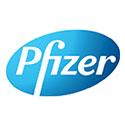The pharmaceutical company, No. 1 in the InformationWeek Elite 100 ranking, uses big data to tailor treatments to specific patient populations.

Lots of companies boast about big data, but Pfizer is delivering on its promise with the Precision Medicine Analytics Ecosystem, a program that connects the dots among genomic, clinical trial, and electronic medical record data to spot opportunities to quickly deliver new drugs for specific patient populations.
Five to seven years ago, the conventional model for developing drugs was to design multiyear clinical trials that might involve thousands of patients worldwide. Researchers looked into many possible outcomes and potential uses for treatments. Now, a much more targeted approach is possible, supported by more-affordable genomic data and more-available (de-identified) EMR data. By combining these sources with the high-scale clinical trial data at Pfizer's disposal, the company can target specific patient populations that aren't responding to currently available treatments.
In the case of lung cancer, for example, medical research revealed that about 5% of patients weren't engaged in high-risk lifestyles -- they weren't heavy smokers, coal miners, or otherwise abusing their lungs. Rather, what they all had in common was a mutation in their ALK gene. With the aid of predictive analysis across genomic, clinical trial, and anonymous EMR data, Pfizer was able to develop Xalkori, a drug first approved by the Food and Drug Administration in 2011 specifically for lung cancer patients with the ALK gene mutation.
Figure 2:  Pfizer's using big data to find treatments for small
Pfizer's using big data to find treatments for small
patient groups, CIO Keisling says.
"Had this compound been tested against a broad spectrum of lung cancer patients, it likely would not have been found to be effective," says Pfizer CIO Jeff Keisling. "With this analytics-based approach, it was found to be very effective, but we had to be able to identify a subset of cancer patients with a specific gene mutation who previously did not have this treatment option."
[For more InformationWeek Elite 100 coverage and a complete listing of the top 100 companies click here.]
Each of the three platforms Pfizer developed for its ecosystem program represents a huge achievement in its own right.
1. The genomics research repository is built on tranSMART, an open source data management system initially developed in 2009 by scientists at Johnson & Johnson and Recombinant Data Corp. The idea is to combine genomic data sets, from internal and external sources, using the platform's data standards and processing capabilities.
Pfizer chose tranSMART partly because more than 20 corporate, nonprofit, academic, patient-advocacy, and government organizations have embraced it. Pfizer also likes the fact that the platform is open source, and it has at its core massively parallel processing technology and a set of visualization components, says Deb Bremer, VP of business technology on Pfizer's R&D team. (Bremer reports to Keisling but is an embedded leader of the R&D organization.)
2. Pfizer worked with Oracle and other partners to create a cloud-based clinical data repository called the Clinical Cloud. It's hosted by Oracle and based on its widely used Oracle Life Sciences Hub.
Here, too, there's an eye toward pooling data from multiple sources. Pfizer, the world's largest pharmaceutical company, with $51.5 billion in revenue in 2013, has its own stores of clinical trial data. But it also works with contract research partners that conduct trials on its behalf. What's more, every
big drug is likely to acquire additional clinical data through mergers and acquisitions. The standards built into Oracle's Life Sciences Hub cover integration as well as version control, data security profiles, tracking, time stamps, and data indexing and searching.
"By putting it in the cloud, we created a space where we could aggregate data from different companies, and it frees us to work with any partner as long as they can deliver data to our environment in a standardized way," Bremer explains.
Figure 3: !['By putting [the repository] in the cloud, we created a space where we could aggregate data from different companies.' -- Deb Bremer, VP, Pfizer 'By putting [the repository] in the cloud, we created a space where we could aggregate data from different companies.' -- Deb Bremer, VP, Pfizer](https://eu-images.contentstack.com/v3/assets/blt69509c9116440be8/blt3c4d41e265fd0bf8/6467a6bbaeff3928ac519fd0/Bremmer_Pfizer.jpg?width=700&auto=webp&quality=80&disable=upscale) "By putting [the repository] in the cloud, we created a space where we could aggregate data from different companies." -- Deb Bremer, VP, Pfizer
"By putting [the repository] in the cloud, we created a space where we could aggregate data from different companies." -- Deb Bremer, VP, Pfizer
3. The EMR component of Pfizer's data ecosystem contains "hundreds of millions" of anonymized records, Bremer says. It's built on Teradata; Pfizer uses Tableau Software for data exploration and visualization. The company also uses Tibco Spotfire for data analysis and visualization, but it typically uses that tool in the tranSMART and Clinical Cloud environments.
Many pharmaceutical, research, academic, and healthcare organizations are trying to take advantage of the vastly larger genomic and medical record data sets that have become available over the last few years. Pfizer's Precision Medicine Analytics Ecosystem stands out because it taps all three data types and makes them readily available to company researchers at scale with tools they can use for predictive analysis.
"It gives us the ability to model and predict outcomes in certain patient populations, and that presents a massive opportunity to bring more therapeutics to market very quickly," Keisling says. "Previously, it all had to be done with testing on humans, and that means trial and error, expense, and risk."
If Pfizer researchers notice patterns in medical record data that lead to a hypothesis, they can quickly determine whether the hypothesis is validated in clinical trial data. They also can turn to the genetic data to better understand the character and size of a patient population that might benefit from a novel treatment. With predictive analysis across all three data sets, Keisling and Bremer say, Pfizer can quickly determine how best to design a much more focused clinical trial and what part of the body to target in connection with a particular disease.
Pfizer already has several products on the market and many others in development that have benefited from high-scale analysis across genetic, clinical, and medical record data, Keisling says. "We expect significant progress in the short term and the long term thanks to this ecosystem," he says. "So we're not just waiting for the benefit. We're seeing it now."
IBM, Microsoft, Oracle, and SAP are fighting to become your in-memory technology provider. Do you really need the speed? Get the digital In-Memory Databases issue of InformationWeek today.
About the Author(s)
You May Also Like







